
by Susan Brady | Sep 10, 2021 | Healthy aging

Why is it so hard to discard “bad” habits and instill sustainable “healthy” ones? One reason is that most of us thrive on routine and consistency and shy away from change. The human brain actually uses various methods to stop a person from making a change. This is because change involves emotions and doing things that are different or unpredictable can be scary.
Making changes becomes even harder during times of stress, fatigue, or overwhelm. Think about all the times you’ve made New Year’s resolutions, or were excited about a new diet or exercise program, or promised yourself that you would start meditating. Then “life” got in the way and all your good intentions went out the window. This is when having a tool that allows you to take action, stick to your plan, and follow through is invaluable. One of the tools I use to stay on track is called the 5-second rule.
The 5-second rule, created by Mel Robbins, author, speaker, and life coach, is often described as the ultimate brain hack for keeping you focused and moving towards your goals. It is a tool that can help you take action in any situation.
This is the way it works:
According to Mel Robbins, when you are faced with a challenge or a decision, you only have 5 seconds to take action and make the right choice.
The tool is simple and straightforward. When making a decision or leaning towards that unhealthy food choice, procrastinating with exercise, or talking yourself out of doing something you know you really should do, you simply start to count backward 5 – 4 – 3 – 2 – 1 – GO. At GO, you take action!
The count down forces your brain to act and helps to push you toward what you know is doing the right thing, the healthy habit, the healthy choice.
This is why it works:
Although there is a lot of neuroscience behind why this works, the most simplistic explanation is that the count down takes you out of your emotional brain and engages the part of your brain that makes decisive decisions.
The fact is that we are emotional beings and most of the time we act impulsively on emotion rather than making purposeful choices.
When you count backward it shifts your thoughts away from the emotional center of your brain to the pre-frontal cortex of the brain. The prefrontal cortex is the area of the brain that is responsible for concentration, planning, and problem-solving.
It also contributes to a variety of executive functions like:
-
Predicting consequences of one’s actions
-
Managing emotional reactions and impulses
-
Processing the information around you and adapting your behavior accordingly
-
Helping you set and achieve goals
Counting backward interrupts that conversation going on in your brain about all the reasons why you don’t want to do something.
For example, your alarm goes off in the morning so you can up and exercise. But instead of getting up, you lie in bed, and swirling around in your brain are all the reasons why you don’t want to get up. Maybe your emotions are telling you that it is too cold, or you are too tired, or you just need a little more sleep. When you start to count backward, all those excuses are shut down and you are up and on the way to the gym!
“The moment you have an instinct to act on a goal you must count 5-4-3-2-1 and physically move or your brain will stop you.” ~ Mel Robbins
I like to think about the 5-second countdown as a rocket blasting off the launch pad. We are all familiar with the 5-4-3-2-1 BLAST OFF and the excitement and action that it brings. At ZERO that rocket goes off, with great force and energy. What is interesting is that counting up from 0-5 doesn’t have the same effect, perhaps because it doesn’t relay the same excitement or urgency.
I have found the 5-second rule to be pretty effective for me. I use it frequently to get out of bed in the morning when my alarm goes off. If I am being drawn in by the smell of the bakery at the food store, I start the countdown and walk right on by. Sometimes I use it at a restaurant when I am hungry and drooling over the comfort foods on the menu. Upon ordering, I count backward… 5-4-3-2-1….and making the healthier choice is easy.
Thinking about making good health decisions is not enough, you have to take action. Most of us know what we need to do to be healthier, but all too often our brain sabotages us, and this is where I have found the 5-second rule to be very helpful.
It’s a simple, quick, and effective tool for overcoming obstacles that might be holding you back and preventing you from reaching your goals.
Try it! Let me know how it works for you!
Need some guidance on making your health habits sustainable? Reach out! I am always happy to help.
Susan@nurturedbones.com/703.738.4230
Check out all of Mel Robbin’s work at melrobbins.com
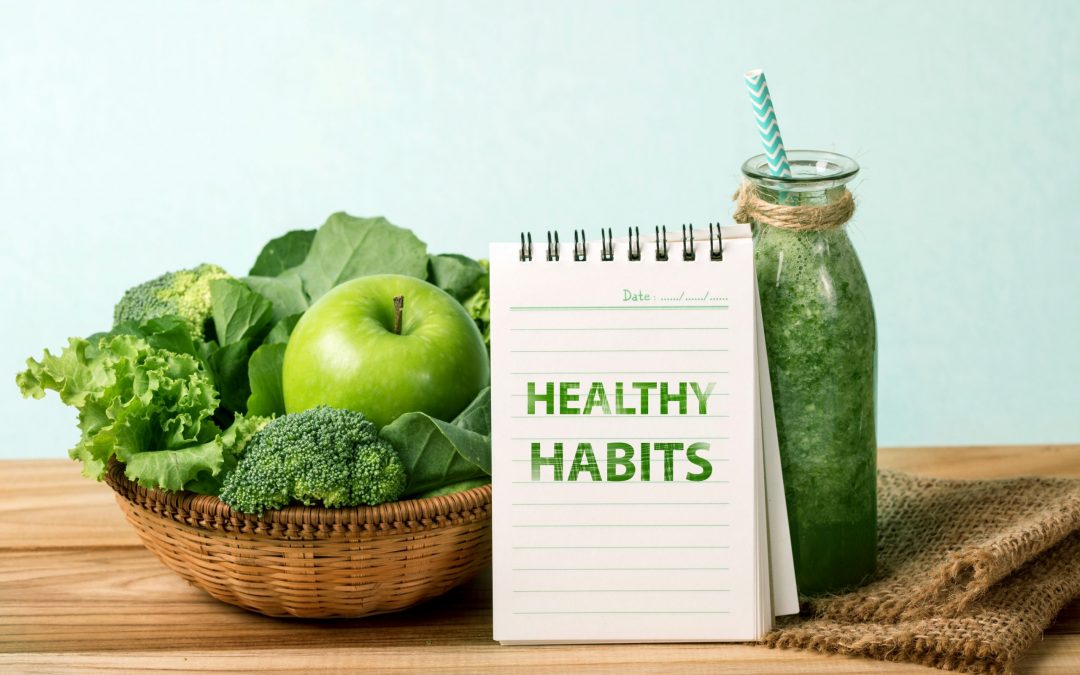
by Susan Brady | Sep 2, 2021 | Healthy aging
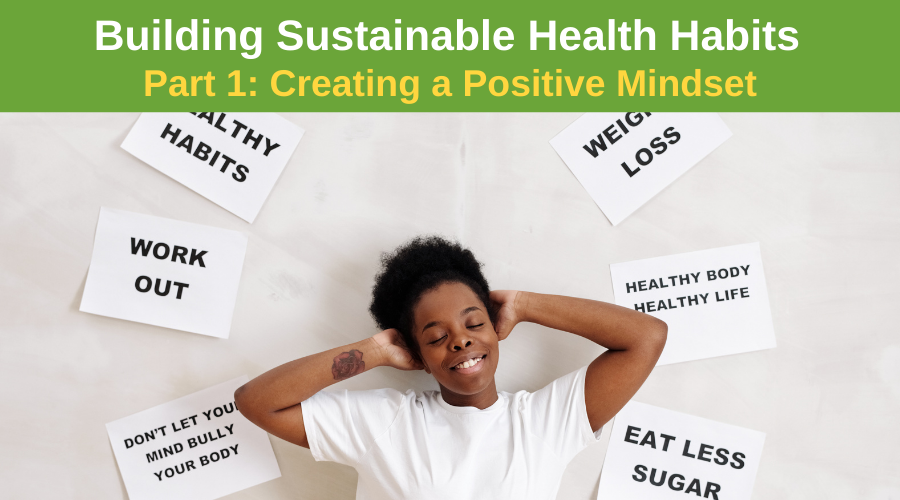
Building sustainable health habits is hard! We all know that we need to eat more vegetables, get regular exercise, sleep more, and incorporate a daily stress-reducing routine. But making, and sticking to, these changes is hard. One of the reasons why sustaining healthy habits is so hard is because we are emotional beings and many of our habits are driven by how we feel. Many of our unhealthy habits are driven by negative emotions and breaking bad health habits and instilling healthy habits requires a positive mindset.
If you are waking up in the morning and looking in the mirror and thinking, ugh, I have gained so much weight, or have gotten so flabby, or look so old, or stressed. Or if you jump out of bed thinking about all the things you have to do and how stressful your day is going to be, you are setting up for a day of failure. Not only will you struggle to achieve your daily goals, but you are also telling yourself that you are not worthy of getting healthy, nor do you have the time or energy to focus on your health. Your emotions and outlook on life are key components for creating healthy habits.
Here are 2 quick and easy ways that can help flip the switch for a more positive mindset:
The Maui Habit
The Maui habit was developed by Dr. BJ Fogg, a behavior scientist at Stanford University and author of the book Tiny Habits. The habit grew out of inspiration from a birthday card Dr. Fogg received one year from a Hawaiian friend. The words on the front of the card read “Every Day is a Gift.” Being deeply touched by those words, he began incorporating that sentiment into his life by waking up every morning and stating what a great day it is going to be. He began to see how this one tiny habit of starting the day with a positive mindset had a huge impact on his life.
The Maui Habit is to start each day repeating the phrase “today is going to be a great day” or “an awesome day”, or “an amazing day.” Saying and repeating this simple phrase can trigger your brain for positive thoughts and positive outcomes throughout the day. This simple 3-second habit helps to create positive energy for the day, which will intern help you to make positive, healthy choices. Additionally, these positive thoughts crowd out those negative, self-sabotaging thoughts that lead to destructive habits.
Positive Self-Talk
Self-talk is that running internal dialogue that goes on in your head every day. It can be negative like “you are not good enough”, or “you can’t do anything right” or it can be positive like “you are doing great.” The way that you talk to yourself can have a profound impact on your behavior and your habits. It is very hard to stick to a health goal if you don’t feel as if you are ever going to achieve it, or deserve to achieve it. Positive self-talk boosts your self-confidence in your ability to achieve your goals and instills the belief that the things you want are achievable. Then, when you are faced with certain challenges or barriers to your goal, it is easier to find ways to overcome them. Even a small shift in that dialogue in your head towards more positive words can have a tremendous impact on helping you change your behavior and reinforce healthy habits.
Just having a positive mindset can improve your health.
Positive thinking has been associated with:
-
Increased lifespan
-
Lower risk of depression
-
Greater resistance to the common cold
-
Better cardiovascular health and reduced risk of death from cardiovascular disease
-
Better coping skills during stressful times, reducing the harmful effect of stress on your body
People with a positive mindset tend to live healthier lifestyles; they get more physical activity, follow a healthier diet and don’t smoke or drink alcohol in excess.
Keeping a positive mindset, engaging in positive self-talk, starting your day with a positive thought like “it is going to be a great day”, I believe, is the first step in helping you to make those proactive changes that lead to long-term, sustainable health habits.
Need help achieving your health goals? Reach out, I can help! Susan@nurturedbones.com/703.738.4230
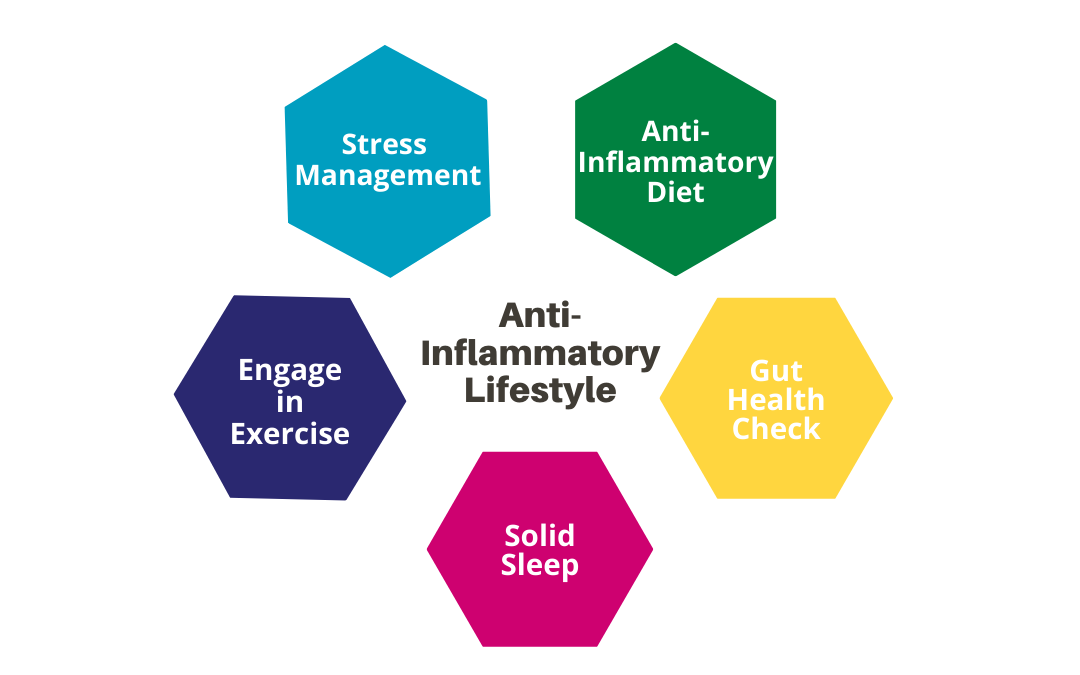
by Susan Brady | Jul 23, 2021 | Digestion

Chronic, systemic inflammation is the type of inflammation that lingers on in the body and damages our cells and our tissues. It can play a huge role in numerous health conditions from cardiovascular disease to diabetes, cancers, and even osteoporosis. Luckily, there are things you can do to put out the fire!
5 Steps to Dousing the Flames
1. Flip the Switch on Stress
One thing that causes inflammation is chronic emotional stress. When we are stressed out it activates our sympathetic nervous system. Our sympathetic nervous system is known as our fight or flight nervous system. When it becomes activated, our body thinks that we are under attack. The sympathetic nervous system revs up our system to get it ready to either fight off the attack or run from it. And one of the ways that it revs up our system is to produce cortisol and other inflammatory proteins. These chemicals are beneficial when we are experiencing short-term stress. However, if they linger as they do with chronic, ongoing stress, they can damage the body and create systemic inflammation.
Having a toolbox of stress-reducing techniques can flip the switch on stress and bring calm to the system. The mind-body techniques such as deep breathing, mindfulness, meditation, Yoga, have all been demonstrated to have a powerful effect for reducing mental stress and relieving inflammatory conditions. My go-to when I am feeling stressed is deep breathing, especially deep breathing with a very slow exhalation. Deep breathing helps to stimulate the vagus nerve. The vagus nerve runs from the brain through the neck and chest area and down to the abdomen and helps to regulate digestion, heart rate, and respiratory rate. When you stimulate the vagus nerve through deep breathing it can lower your heart rate, lower blood pressure, helps to regulate cortisol levels, and suppress inflammation. We are all faced with stress, and that’s not going to change, but what can change is having ways to handle the stress so it doesn’t become chronic and damaging.
2. Engage in Exercise
Exercise also helps to decrease inflammation. As reported in ScienceDaily, a study published in the journal Brain, Behavior and Immunity showed that as little as 20 minutes of exercise reduces inflammation. The exercise doesn’t need to be intense and even 20 minutes of moderate exercise, like walking, can have anti-inflammatory effects. Additionally, regular exercise helps to reduce stress as well as fat mass. Fat, especially abdominal fat, produces inflammatory proteins that contribute to systemic inflammation. Any activity that reduces abdominal fat will reduce systemic inflammation.
3. Get some Solid Sleep
There is a lot of strong evidence that shows a lack of sleep raises levels of inflammation in the body. In fact, a study published back in 2010 revealed that people who sleep poorly or don’t get enough sleep to have higher levels of inflammation. Try your best to get between 7-9 hours of sleep at night. If you struggle with sleep, reach out to your health care practitioner to explore ways to help you get a better night’s sleep.
4. Get your Gut Checked
Another important issue when it comes to combating systemic inflammation is gut health. Digestive and gut dysfunction is one of the greatest contributors to chronic inflammation. Conditions like leaky gut and gut dysbiosis have far-reaching effects throughout the body, from your brain to your bones. If you have symptoms of gas, bloating, indigestion, chronic constipation, brain fog, mood issues, or joint and muscle aches and pains, please get your gut checked.
5. Follow an Anti-inflammatory Diet
Following an anti-inflammatory diet can help support healing if inflammation already exists as well as prevent chronic inflammation in the future. You have to avoid heavily processed, packaged foods with salt and sugar and refined carbohydrates, and pro-inflammatory vegetable oils like corn, sunflower, safflower, and soy. All of these types of food will fuel inflammation.
An anti-inflammatory diet is rich in vegetables, fruits, legumes, nuts, whole grains, and fatty fish. Some of the top vegetables and fruits for reducing inflammation are green leafy vegetables, cruciferous vegetables, garlic, onions, and fruits such as citrus fruits and berries. It is really important to get enough omega 3 fatty acids from foods like wild-caught salmon or sardines as well as flax seeds, chia seeds, and walnuts. There are also many wonderful anti-inflammatory herbs like turmeric, ginger, rosemary, sage, oregano, and cinnamon that can be used to spice up your meals and turn down the heat.
Click Here for a complete guide to the Anti-Inflammatory diet.
Following these lifestyle principles will help to heal and prevent systemic inflammation that can contribute to disease, aging, and osteoporosis.
If you are interested to see if inflammation may be contributing to your health issues, I would recommend filling out the Inflammatory Index Questionnaire to get a baseline of your symptoms. Then after following the principles of an anti-inflammatory lifestyle for several months, retake the questionnaire to see how your symptoms have changed.
Click Here for the Inflammatory Index Questionnaire
Please reach out if I can help you!
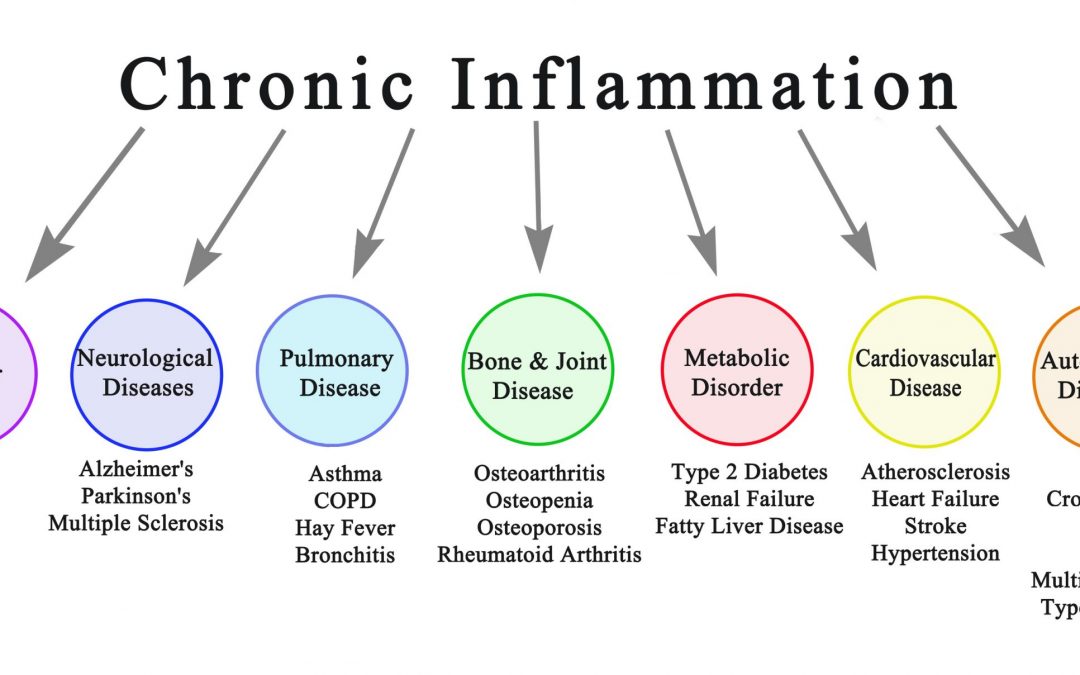
by Susan Brady | Jul 19, 2021 | Digestion
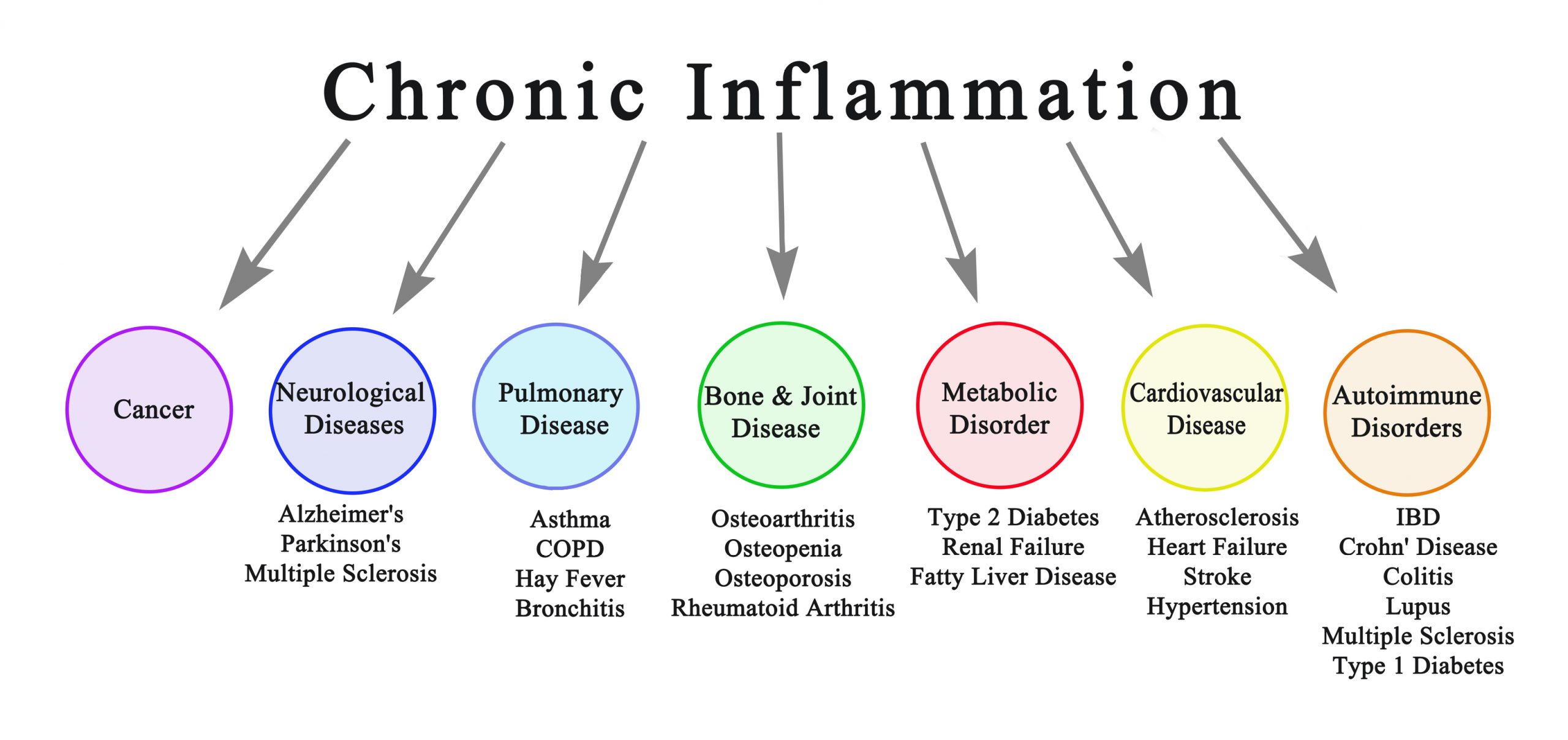
Seven Consequences of Chronic Inflammation
Most people are familiar with the inflammation that occurs when we injure a joint, cut ourselves or develop an infection. This swelling, redness, heat, and pain is one of our body’s most important mechanisms to heal an injury or fight infection. This acute inflammatory process generally lasts a few days and is the body’s way of recovering naturally. However, it is also possible to develop chronic, systemic inflammation, not related to injury or infection, which causes continual low-level inflammation throughout the body. This type of inflammation can result in damage to healthy tissue leading to many diseases, including osteoporosis.
Chronic inflammation has been found to be a culprit in a wide array of health conditions including cardiovascular disease, diabetes mellitus, dementia, asthma, obesity and age-related macular degeneration. There is mounting evidence that suggests chronic systemic inflammation can also contribute to osteoporosis and increase the risk of fractures in aging adults.
Ongoing systemic inflammation may contribute to loss of bone mass and bone strength by affecting the bone remodeling process; the process where old bone is reabsorbed and new bone is laid down. Inflammation causes an increase in osteoclast activity (cells that break down bone) resulting in accelerated bone loss. Over time, this will lead to a decrease in bone mass leaving them weakened and more susceptible to breaking.
Chronic inflammation is generally not caused by a specific injury but things like:
-
Diet high in processed foods, sugar, trans fats
-
Smoking
-
Chronic stress
-
Poor sleep
-
Obesity
-
Unhealthy gut
-
Chronic infections
-
Toxins
What are some signs and symptoms that chronic inflammation may be contributing to your health issue?
-
Chronic body pains, arthritis, muscle pain
-
Constantly being tired or fatigued
-
Mood disorders like depression or anxiety
-
Memory issues or brain fog
-
Frequent colds and infections
-
Abdominal fat
-
Bowel issues
-
Skin rashes
-
Dry eyes
Testing to check for Chronic inflammation:
-
C-Reactive Protein (CRP): CRP levels increase in the blood when there is a condition causing inflammation.
-
Homocysteine: High levels of homocysteine can be linked to inflammation
-
Omega 3 fatty acids: Low levels of omega 3 fatty acids can contribute to inflammation
-
Anti-Oxidants: CoQ10, vitamins E, A and C are all powerful anti-oxidants that are needed to protect your cells against inflammation
There are many comprehensive tests available, beyond the common blood test, that can test for not only CRP and homocysteine but also for the important anti-oxidants and fatty acids
If you are interested, please reach out to me. susan@nurturedbones.com
Coming up next, lifestyle habits to help reduce and control chronic inflammation!
But in the meantime, I have put together an anti-inflammatory questionnaire that walks you through all of the different signs and symptoms of inflammation. You can use the questionnaire to rate your symptoms now and then again in 1-2 months from now after following an anti-inflammatory diet and lifestyle.
You can download the Inflammatory questionnaire/index HERE.

by Susan Brady | Jun 14, 2021 | Supplements

The fifth pillar of my BONES Method is Smart Supplementation. Trying to figure out what supplements you should be taking to keep your bones strong and healthy can be very confusing.
We all know that calcium and vitamin D are important for bone health, but the truth is that our bones need a constant supply of over 20 different nutrients. Ideally, we should get these nutrients from food. Unfortunately, modern farming practices, the use of pesticides and synthetic fertilizers, and the erosion of nutrient-rich topsoil has led to a decline in the concentration of nutrients in our food. Some sources suggest that our food today may be up to 40% less nutritious than it was 50 years ago!
Although I am an advocate of “food first,” getting all the nutrients your bones need from food is difficult and supplementation is often necessary.
What supplements should you be taking? Figuring this out can be tricky. We are all metabolically and biochemically unique individuals and the nutrients required for one person might be very different from those required for another. So making generalized supplement recommendations in a blog can be tough, but I do have 5 nutrients that I feel almost everyone needs to be supplementing.
5 Nutrient Supplements Essential for Bone Health
1. Calcium. I know there is a lot of controversy over calcium supplements. Many feel that calcium, especially in the form of supplementation, is not beneficial and can actually be harmful. However, I believe that it is very hard to get all the calcium your bones need from food, especially if you are sensitive to dairy products or have issues with oxalates. Foods highest in calcium include dairy, leafy green vegetables and some nuts, like almonds, and seeds like chia and sesame seeds. If you are sensitive to dairy products and rely heavily on green leafy vegetables for calcium, you need to be careful about the oxalates in greens such as spinach, collard greens, and swiss chard which can prevent absorption of calcium. So you can see where it can get tricky for people like me who are sensitive to dairy and oxalates!
It is also important to remember that calcium is a critical nutrient for so many processes in the body, like muscle contraction, nerve conduction, blood clotting, and blood pressure. When you are not taking in enough calcium, your body will draw calcium out of the bones, where it provides strength and structure, to supply calcium for these other functions. So although many in the field of nutrition don’t think people should be supplementing with calcium, I think it is critical to make sure you are getting enough.
My general rule of thumb when it comes to calcium is to calculate, the best you can, the amount of calcium you get in your diet and then supplement to reach 1000 mg of calcium a day. If you calculate that you are getting 800 mg of calcium in your diet, then you only need to supplement with 200 mg. If you are not getting enough calcium from your diet, low-dose supplementation (200-300 mg) can help. In order to safely supplement with calcium, you also need to supplement with vitamin K2, vitamin D, and magnesium.
2. Vitamin K2. As I have talked about in the past, K2 is the nutrient that shuttles calcium into the bone so it doesn’t settle in the blood vessels or other soft tissue. Vitamin K-2 has been found to activate the protein osteocalcin which helps to integrate calcium into the bone where it belongs. I generally recommend 100-200 mcg of vitamin K2 a day.
3. Vitamin D3. Although our body makes vitamin D from the sun, most of us have a hard time making enough vitamin D because we spend most of our days inside, use sunscreen when we go out or live in the northern latitudes where it is impossible to get adequate sun rays for 6-8 months of the year. The amount of vitamin D that you need is very individual and should be based on serum blood levels. Most labs give a reference range that indicates that anything over 30 nanograms/mL is considered normal. However, there is an abundance of research that suggests vitamin D levels should be higher than that. I like to see vitamin D levels in the range of 50-60 ng/L. A rule of thumb for dosing vitamin D is to take 1000 IUs of vitamin D3 to increase serum levels about 10ng/mL. I don’t believe in mega dosing of vitamin D as there has been some recent research indicating that too much vitamin D can actually have a detrimental effect on our bones. With moderate supplementation, it has been shown to take about 6 weeks for serum levels to reach their peak.
4. Magnesium. Magnesium is also one of my top supplements because it’s necessary for the proper utilization of vitamin D and calcium. It’s needed to balance two very important hormones, calcitonin, and PTH, which regulate the absorption of calcium into bone. Magnesium also supports just about every function in our body! I generally recommend supplementing with equal amounts of calcium and magnesium. If you are taking 200 mg of calcium, then you need to supplement with 200 mg of magnesium. Even if you are not taking calcium supplements, I generally recommend that people supplement with magnesium since magnesium deficiency is common. Generally, 200 to 350 mg/day is a good amount. Taking over 350 mg/d may start to cause loose stools.
5. Omega 3 Fatty Acids. The omega 3 fatty acids in fish oils help to fight inflammation. Unless you are eating fatty fish, flax and chia seeds every day, it is hard to get enough of these beneficial oils in our diet. Additionally, most of us end up getting too much omega 6 fatty acids from vegetable oils and nuts. Too many omega 6 fatty acids and enough omega 3 fatty acids can actually contribute to inflammation in the body. Inflammation is one of the root causes of bone loss and osteoporosis. Anything that promotes inflammation activates your osteoclast cells, which leads to the breakdown of your bones. EPA and DHA are the 2 most important anti-inflammatory fatty acids in fish oil. Although different amounts of EPA and DHA have different purposes, a general daily dose of about 300-500 mg of EPA and DHA are beneficial for fighting inflammation. It is essential to find a high-quality fish oil that has been 3rd party tested for purity.
Beyond the above, there are a lot of other nutrients our bones need like boron, zinc, manganese, and vitamins C and B. However, generally, these nutrients can be obtained through diet if you are eating healthily.
Try to meet your nutrient needs with food first, and use supplements to fill in the gaps.
I do offer a supplement review….where I go over your health history, your medications, your diet, your lifestyle and then put together a more personalized supplement protocol for you.
If interested, please reach out to me at susan@nurturedbones.com or schedule a free 15 min consult by CLICKING HERE.










